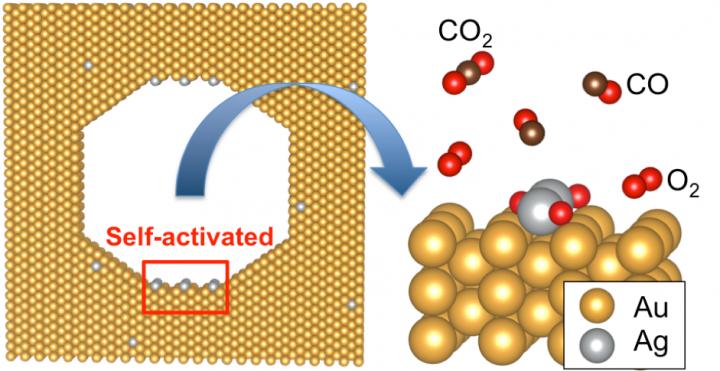Hope for new catalysts with high activity

This is an active structure in a nanoporous gold catalyst. Credit: Osaka University
Gold is a metal that is chemically inactive and does not corrode, but nanoporous gold (NPG), with its sponge-like structures, acts as a catalyst to promote chemical reactions such as carbon monoxide (CO) oxidation. Its mechanisms, however, remained unclear.
Osaka University scientists elucidated the activation mechanism of NPG catalysts that made poisonous CO gas harmless. Their research results were published in Nature Communications.
The researchers performed in situ analysis using atomic-scale resolution environmental transmission electron microscopy (ETEM) equipped with a high-speed camera, clarifying the catalytically active structure of NPG in low-temperature CO oxidation. They succeeded in visualizing self-activation on the surface of a nanostructured catalyst. ETEM observation and computer simulations revealed that this nanostructure contained residual impurities, which played an important role in catalyzing chemical reactions.
Lead author Naoto Kamiuchi said, “The results of our study will provide a clue to the clarification of reaction mechanisms of various solid catalysts used for industrial purposes, leading to the development of new highly active catalysts necessary for solving energy issues.
###
Osaka University was founded in 1931 as one of the seven imperial universities of Japan and now has expanded to one of Japan's leading comprehensive universities. The University has now embarked on open research revolution from a position as Japan's most innovative university and among the most innovative institutions in the world according to Reuters 2015 Top 100 Innovative Universities and the Nature Index Innovation 2017. The university's ability to innovate from the stage of fundamental research through the creation of useful technology with economic impact stems from its broad disciplinary spectrum.
Website: http://resou.
Media Contact
All latest news from the category: Life Sciences and Chemistry
Articles and reports from the Life Sciences and chemistry area deal with applied and basic research into modern biology, chemistry and human medicine.
Valuable information can be found on a range of life sciences fields including bacteriology, biochemistry, bionics, bioinformatics, biophysics, biotechnology, genetics, geobotany, human biology, marine biology, microbiology, molecular biology, cellular biology, zoology, bioinorganic chemistry, microchemistry and environmental chemistry.
Newest articles

Trotting robots reveal emergence of animal gait transitions
A four-legged robot trained with machine learning by EPFL researchers has learned to avoid falls by spontaneously switching between walking, trotting, and pronking – a milestone for roboticists as well…

Innovation promises to prevent power pole-top fires
Engineers in Australia have found a new way to make power-pole insulators resistant to fire and electrical sparking, promising to prevent dangerous pole-top fires and reduce blackouts. Pole-top fires pose…

Possible alternative to antibiotics produced by bacteria
Antibacterial substance from staphylococci discovered with new mechanism of action against natural competitors. Many bacteria produce substances to gain an advantage over competitors in their highly competitive natural environment. Researchers…





















